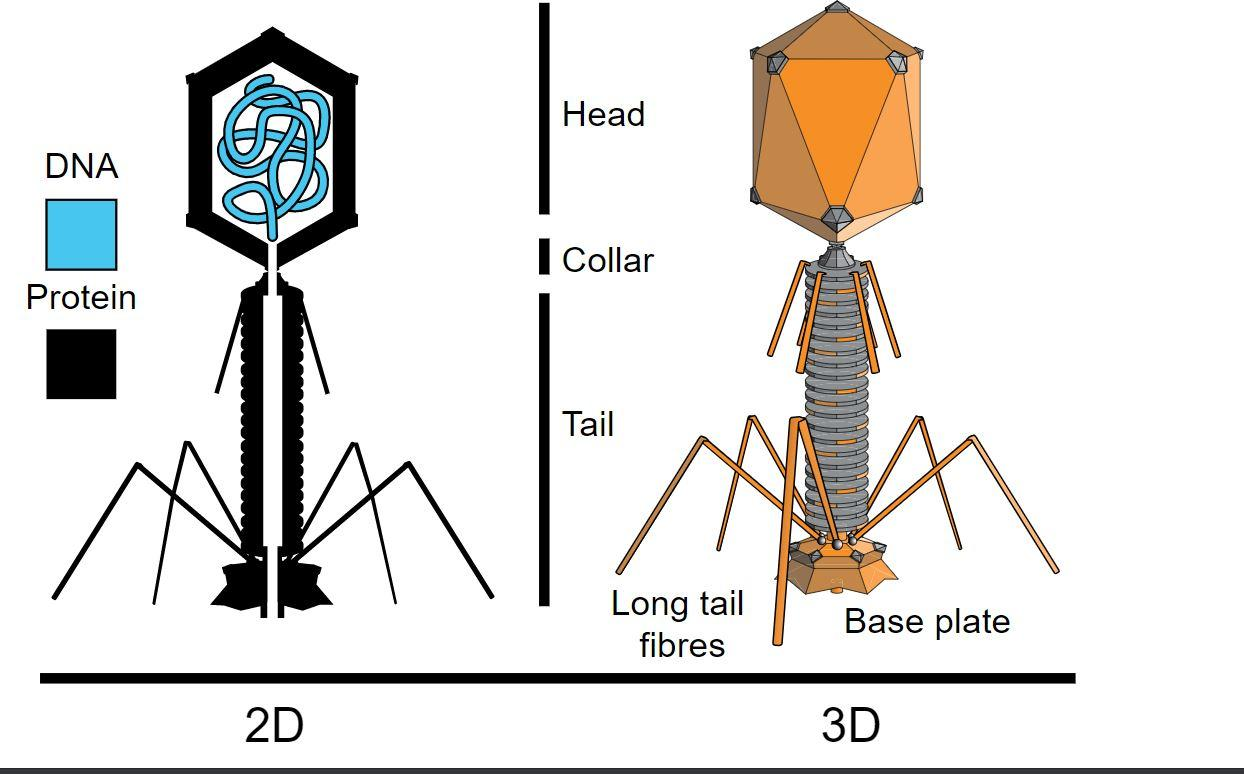
Draw a labeled diagram of bacteriophage.
Answer
463.8k+ views
Hint: Viruses are microscopic parasites and contagious agents with living and nonliving characteristics. These viruses can infect plants, animals, and other microorganisms.
Complete answer:
Viruses are non-cellular, microscopic, and infectious agents that live by depending upon the host cell. They contain genetic material as RNA or DNA and proteins; they invade and reproduce by using organisms, plants, and animal cellular organelles as they lack the required cellular material.
Certain viruses that infect bacteria are known as Bacteriophage or phage i.e. bacteria eater. Bacteriophages are the viruses that parasitize them and reproduce inside them. Some of their characteristics are:
a) These Bacteriophages like other viruses also consist of a core of genetic material that is surrounded by a capsid.
b) Genetic material of bacteriophage can either be DNA or RNA according to their general composition.
c) After infecting bacterial host cells they hijack the cellular control of the host cell and stop them from producing bacterial components and force them to produce viral components.
d) They generally bring about the lysis of bacterial host cells.
Structural composition of Bacteriophage:
Typical bacteriophage composed of a polyhedral head, a short collar, and a helical tail.
The Head is hexagonal and consists of 2000 capsomeres with genetic material double-stranded DNA or single-stranded RNA present in the head.
Collar and whiskers of phage help to attach the six long tail fibers to the phage particle during virus assembly.
The tail is cylindrical and is composed of a central hollow tube which is surrounded by a contractile sheath (protein) with annular rings and the distal end of the tail consists of a basal plate that has tail fibers.
Diagram showing the structure of bacteriophage:

Note:
Bacteriophage replicates inside the bacterial cell with the help of a cycle either a lytic or lysogenic cycle. These Bacteriophages are highly specific for their target bacteria, and also effective against multi-resistant pathogens.
Complete answer:
Viruses are non-cellular, microscopic, and infectious agents that live by depending upon the host cell. They contain genetic material as RNA or DNA and proteins; they invade and reproduce by using organisms, plants, and animal cellular organelles as they lack the required cellular material.
Certain viruses that infect bacteria are known as Bacteriophage or phage i.e. bacteria eater. Bacteriophages are the viruses that parasitize them and reproduce inside them. Some of their characteristics are:
a) These Bacteriophages like other viruses also consist of a core of genetic material that is surrounded by a capsid.
b) Genetic material of bacteriophage can either be DNA or RNA according to their general composition.
c) After infecting bacterial host cells they hijack the cellular control of the host cell and stop them from producing bacterial components and force them to produce viral components.
d) They generally bring about the lysis of bacterial host cells.
Structural composition of Bacteriophage:
Typical bacteriophage composed of a polyhedral head, a short collar, and a helical tail.
The Head is hexagonal and consists of 2000 capsomeres with genetic material double-stranded DNA or single-stranded RNA present in the head.
Collar and whiskers of phage help to attach the six long tail fibers to the phage particle during virus assembly.
The tail is cylindrical and is composed of a central hollow tube which is surrounded by a contractile sheath (protein) with annular rings and the distal end of the tail consists of a basal plate that has tail fibers.
Diagram showing the structure of bacteriophage:

Note:
Bacteriophage replicates inside the bacterial cell with the help of a cycle either a lytic or lysogenic cycle. These Bacteriophages are highly specific for their target bacteria, and also effective against multi-resistant pathogens.
Recently Updated Pages
Master Class 9 General Knowledge: Engaging Questions & Answers for Success

Master Class 9 English: Engaging Questions & Answers for Success

Master Class 9 Science: Engaging Questions & Answers for Success

Master Class 9 Social Science: Engaging Questions & Answers for Success

Master Class 9 Maths: Engaging Questions & Answers for Success

Class 9 Question and Answer - Your Ultimate Solutions Guide

Trending doubts
Types of lever in which effort is in between fulcrum class 12 physics CBSE

Distinguish between esterification and saponification class 12 chemistry CBSE

Which are the Top 10 Largest Countries of the World?

A two input XOR Gate produces a high output only when class 12 physics CBSE

Give five points to show the significance of varia class 12 biology CBSE

Which is the correct genotypic ratio of mendel dihybrid class 12 biology CBSE




